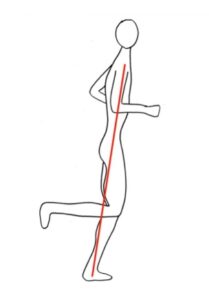We all know how to run, right? Not necessarily. If you go to your local park and watch people running, you’ll see a million different styles. There’s the shuffler, barely picking up their feet. There’s the twister, with their whole upper body twisting with each step. There is the leg flicker with the lower legs flying out to the side. The list goes on. Now watch a 6-year-old run. They’ve probably got it about right because they haven’t picked up any bad habits yet.
So what if you run like a Shetland pony with a heavy load? Where’s the harm? For some, there’s no harm. But for others, poor form can result in repetitive injuries that refuse to go away. For everyone, the beauty of improving your running form is that it makes you more efficient, less prone to injury, and often quite a bit faster. If you go in to a running shop, they’ll often point a camera at your feet and prescribe some trainers that aim to fix your problem. But quite a few problems are fairly simple to correct with an improvement in form.
Here are a few tips to think about when you are next out in the park…
- CORE
People tend to talk about core strength a lot in fitness. In running, your posture is very important. The aim is to have your spine in a ‘neutral’ position, your pelvis level and your core muscles engaged. Your posture and core stability affects everything else you do – from the way you use your arms to how heavily you land. So by improving your posture, your core, stability muscles will be working better to support you.
Think about an imaginary bit of rope coming out of your head. Simply imagine that someone above is pulling that rope and lifting your head off your shoulders, lengthening the space between your earlobes and shoulders. Relax from the shoulders down and keep your eye sight forwards and not down.

2. LEG CYCLE
Your leg cycle should go like this: foot strikes ground roughly underneath the hips, leg pulls back, heel picks up to around knee height, and the knee drives through to begin the cycle again. If you follow the path of the heel looking from the side, there should be a circular motion of the leg cycle. Your gluts and hamstrings should do most of the work, while your feet and lower legs should remain relaxed. A common problem is over-striding where your foot lands too far in front of you. This essentially puts the break on every time you land, slowing you down and causing you to take the shock of landing through your heel.
If you’re an over-strider, focus on picking your heel up behind you as the foot leaves the ground. As the leg moves forward concentrate on lifting the knee slightly up in front.
Concentrate on either the heel lifts for a period of 20-30 seconds or the knee lifts for a similar period. Avoid doing both at the same time. At Chiswick Physio we would also advise to do some gluteal strengthening exercises to make sure your quads aren’t over compensating for a weak bottom.

- ARMS
You might be surprised to hear that your arms are responsible for quite a bit of the power when you’re running. They should be bent and remain at 90 degrees at the elbow, and your thumbs should be pointing upwards. They should pull back so your fist is brushing your pelvis at hip level and then forward so fist is at shoulder height, in front of the shoulder. Try to use a fluid arm movement backwards and forwards, pushing much further backward than forward. Posturally, this should open up the shoulders, and increase mobility in the upper back.
Avoid taking the arms across your trunk. You often see people who don’t move their arms much when they run and they tend to twist their whole upper body as a result. That has a knock on effect all the way down the body, even changing how you land. The answer is to make sure your arms are moving like a pendulum, forwards and backwards.

For that little bit of extra oomph…
- Get a friend to film you running from the side so you can see your style.
- Make corrections in small doses, focusing on your form for just a few minutes at a time during your runs to get it right.
- Contact us here at Chiswick Physio for a dynamic assessment of your biomechanics and a specific strengthening programme.
And for a bit of inspiration, watch the perfect form of some of the world’s elite distance runners like Haile Gebrselassie.
Happy running, folks.





